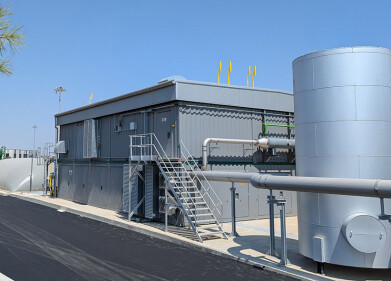Air clean up
Technology Sets New Standard for the Treatment of High Volume Stationary Source Diesel Emissions
Sep 19 2008
Barry Wallerstein, Executive Director of the South Coast Air Quality Management District (AQMD) was a prominent speaker; the roster also included Wayne Nastri, Region 9 Administrator for the U.S. EPA.
The Cloud Chamber Scrubber (CCS) achieved reduction rates that effectively establish a new standard for the treatment of highvolume
diesel emissions. Performance efficiencies of the CCS, detailed at the event, were high for all target pollutants:
Particulate Matter - 98% reduction
SO2 - 98% reduction
NOx - 99% reduction
The Tri-Mer CCS uses patented, “charged droplet†technology to remove particulate and SO2 pollutants. Diesel particulate is less than 0.1 micron in size and is one of the most difficult particulates to control. The CCS employs a special preconditioning process that allows particles to be captured by the charged droplets while simultaneously removing the SO2.
NOx is treated by a selective catalytic reduction (SCR) module which is a factory-integrated option of the CCS system. PM and sulfur that might otherwise impede catalyst efficiency and service life are removed prior to NOx treatment, so exceptional results are consistently achievable.
Tri-Mer Corporation provided all the air pollution control technology, including controls and integration of the SCR.
Equipment engineering and manufacturing was completed at its Michigan factory. Tri-Mer was also responsible for helping coordinate installation and demonstration of the technology.
Advanced particulate characterization equipment was used to calibrate the CCS system. The ship exhaust was brought to the dock-side CCS system using a capture device developed by ACTI (Rancho Dominguez, CA), the environmental company that hosted the media day. The government agencies and other stakeholders at the Port contracted with an independent third party testing company and laboratory to provide standard testing and analysis of PM, SO2, and NOx for independent
verification.
With the successful demonstration test at the Port of Long Beach, and a similar demonstration on diesel locomotive emissions at Union Pacific (Roseville, CA), CCS is now regarded as the first technology to prove consistent high removal efficiencies when operating at the flow volumes typical for large diesel engines.
Events
May 11 2025 Vienna, Austria
May 18 2025 Algiers, Algeria
23rd International Water Management Exhibition
May 20 2025 Prague, Czech Republic
Singapore International Water Week Spotlight 2025
Jun 23 2025 Singapore
Jun 25 2025 Sao Paulo, Brasil














